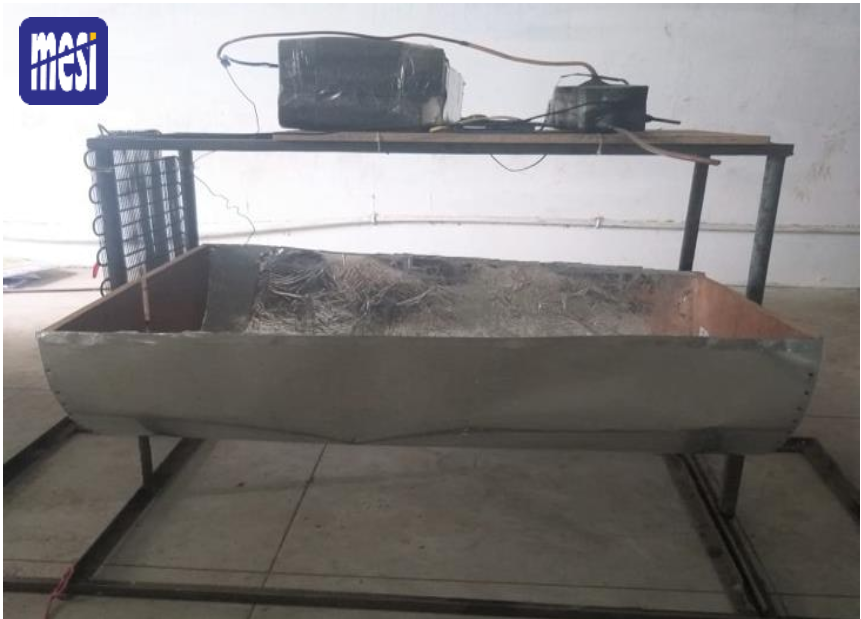Mini cold storage using the parabolic solar trough: An appropriate technology for perishable agricultural product
Main Article Content
Abstract
Limited storage of perishable agricultural products is a common problem for small-scale farmers. Therefore, our approach for this problem is to develop a low operating cost mini cold storage using solar energy. The integration of solar thermal energy with vapor absorption refrigeration systems was studied. In vapor absorption systems, heat energy is taken as the source of input energy and the performance characteristics depend on heat energy supplied and pump work used. The novelty of our project is that it uses a parabolic solar heat collector to run a vapor absorption refrigeration system using heat energy extracted from solar energy. In this cyclic process, the refrigerating effect is produced. By utilizing this mini cold storage system, tomatoes can be stored for four weeks whereas, with room temperature storage, it only lasts one week. This appropriate technology promises small-scale farmers to keep their perishable agricultural products for several weeks without additional storage costs.
Downloads
Article Details

This work is licensed under a Creative Commons Attribution-NonCommercial 4.0 International License.
References
[2] S. A. Shehata, S. Z. Abdelrahman, M. M. A. Megahed, E. A. Abdeldaym, M. M. El-Mogy, and K. F. Abdelgawad, “Extending shelf life and maintaining quality of tomato fruit by calcium chloride, hydrogen peroxide, chitosan, and ozonated water,” Horticulturae, vol. 7, no. 9, 2021.
[3] M. Dhaliwal, “Classification of Vegetable Crops,” 2017, pp. 12–17.
[4] M. A. Click and R. Ridberg, “Saving food: Food preservation as alternative food activism,” Environmental Communication, vol. 4, no. 3, pp. 301–317, 2010.
[5] W. Martindale and W. Schiebel, “The impact of food preservation on food waste,” British Food Journal, 2017.
[6] A. Raffo et al., “Impact of early harvesting and two cold storage technologies on eating quality of red ripe tomatoes,” European Food Research and Technology, vol. 244, no. 5, pp. 805–818, 2018.
[7] M. Seng, B. Buntong, A. L. Acedo, W. Easdown, J. A. Hughes, and J. D. H. Keatinge, “Low-cost cold storage of tomato in modified atmosphere packaging,” in III Southeast Asia Symposium on Quality Management in Postharvest Systems 1179, 2015, pp. 197–200.
[8] T. Krishnakumar, “Design of cold storage for fruits and vegetables,” Tamil Nadu Agricultural University, pp. 1–58, 2002.
[9] Indiaagronet, “Storage Methode,” indiaagronet.com, 2016. .
[10] S. Singh, “Preservation technologies for fresh fruits and vegetables,” Stewart Postharvest Review, vol. 7, no. 1, pp. 1–7, 2011.
[11] G. Velderrain-Rodríguez, A. Quiros, G. Aguilar, M. Siddiqui, and J. F. Ayala-Zavala, “Technologies in Fresh-Cut Fruit and Vegetables,” in Food Engineering Series, 2015, pp. 79–103.
[12] L. Ji, J. Pang, and S. Li, “Application of new physical storage technology in fruit and vegetable industry,” African Journal of Biotechnology, vol. 11, no. 25, pp. 6718–6722, 2012.
[13] M. Setiyo, B. Waluyo, Ba. C. Purnomo, D. W. Karmiadji, and I. C. Setiawan, “Potential of ½ cycle refrigeration system for food transport application,” 2018.
[14] K. F Abdelgawad, M. M El-Mogy, M. IA Mohamed, C. Garchery, and R. G Stevens, “Increasing ascorbic acid content and salinity tolerance of cherry tomato plants by suppressed expression of the ascorbate oxidase gene,” Agronomy, vol. 9, no. 2, p. 51, 2019.
[15] G. Tsaniklidis et al., “The role of temperature in mediating postharvest polyamine homeostasis in tomato fruit,” Postharvest Biology and Technology, vol. 179, p. 111586, 2021.
[16] C. Zeng, P. Tan, and Z. Liu, “Effect of exogenous ARA treatment for improving postharvest quality in cherry tomato (Solanum lycopersicum L.) fruits,” Scientia Horticulturae, vol. 261, p. 108959, 2020.
[17] M. Al-Dairi, P. B. Pathare, and R. Al-Yahyai, “Effect of postharvest transport and storage on color and firmness quality of tomato,” Horticulturae, vol. 7, no. 7, p. 163, 2021.
[18] G.-F. Yao et al., “Hydrogen sulfide maintained the good appearance and nutrition in post-harvest tomato fruits by antagonizing the effect of ethylene,” Frontiers in plant science, vol. 11, p. 584, 2020.
[19] Y. Zhu et al., “Effect of nano-SiOx/chitosan complex coating on the physicochemical characteristics and preservation performance of green Tomato,” Molecules, vol. 24, no. 24, p. 4552, 2019.
[20] X. Tao et al., “Effects of exogenous abscisic acid on bioactive components and antioxidant capacity of postharvest tomato during ripening,” Molecules, vol. 25, no. 6, p. 1346, 2020.
[21] N. Tzortzakis, P. Xylia, and A. Chrysargyris, “Sage essential oil improves the effectiveness of Aloe vera gel on postharvest quality of tomato fruit,” Agronomy, vol. 9, no. 10, p. 635, 2019.
[22] M. M. El-Mogy, A. Parmar, M. R. Ali, M. E. Abdel-Aziz, and E. A. Abdeldaym, “Improving postharvest storage of fresh artichoke bottoms by an edible coating of Cordia myxa gum,” Postharvest Biology and Technology, vol. 163, p. 111143, 2020.

